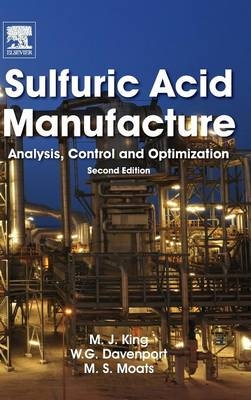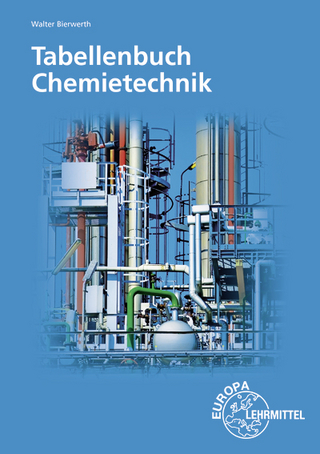
Sulfuric Acid Manufacture
Elsevier / The Lancet (Verlag)
978-0-08-098220-5 (ISBN)
By some measure the most widely produced chemical in the world today, sulfuric acid has an extraordinary range of modern uses, including phosphate fertilizer production, explosives, glue, wood preservative and lead-acid batteries. An exceptionally corrosive and dangerous acid, production of sulfuric acid requires stringent adherence to environmental regulatory guidance within cost-efficient standards of production.
This work provides an experience-based review of how sulfuric acid plants work, how they should be designed and how they should be operated for maximum sulfur capture and minimum environmental impact. Using a combination of practical experience and deep physical analysis, Davenport and King review sulfur manufacturing in the contemporary world where regulatory guidance is becoming ever tighter (and where new processes are being required to meet them), and where water consumption and energy considerations are being brought to bear on sulfuric acid plant operations. This 2e will examine in particular newly developed acid-making processes and new methods of minimizing unwanted sulfur emissions.
The target readers are recently graduated science and engineering students who are entering the chemical industry and experienced professionals within chemical plant design companies, chemical plant production companies, sulfuric acid recycling companies and sulfuric acid users. They will use the book to design, control, optimize and operate sulfuric acid plants around the world.
Professor William George Davenport is a graduate of the University of British Columbia and the Royal School of Mines, London. Prior to his academic career he worked with the Linde Division of Union Carbide in Tonawanda, New York. He spent a combined 43 years of teaching at McGill University and the University of Arizona. His Union Carbide days are recounted in the book Iron Blast Furnace, Analysis, Control and Optimization (English, Chinese, Japanese, Russian and Spanish editions). During the early years of his academic career he spent his summers working in many of Noranda Mines Company’s metallurgical plants, which led quickly to the book Extractive Metallurgy of Copper. This book has gone into five English language editions (with several printings) and Chinese, Farsi and Spanish language editions. He also had the good fortune to work in Phelps Dodge’s Playas flash smelter soon after coming to the University of Arizona. This experience contributed to the book Flash Smelting, with two English language editions and a Russian language edition and eventually to the book Sulfuric Acid Manufacture (2006), 2nd edition 2013. In 2013 co-authored Extractive Metallurgy of Nickel, Cobalt and Platinum Group Metals, which took him to all the continents except Antarctica. He and four co-authors are just finishing up the book Rare Earths: Science, Technology, Production and Use, which has taken him around the United States, Canada and France, visiting rare earth mines, smelters, manufacturing plants, laboratories and recycling facilities. Professor Davenport’s teaching has centered on ferrous and non-ferrous extractive metallurgy. He has visited (and continues to visit) about 10 metallurgical plants per year around the world to determine the relationships between theory and industrial practice. He has also taught plant design and economics throughout his career and has found this aspect of his work particularly rewarding. The delight of his life at the university has, however, always been academic advising of students on a one-on-one basis. Professor Davenport is a Fellow (and life member) of the Canadian Institute of Mining, Metallurgy and Petroleum and a twenty-five year member of the (U.S.) Society of Mining, Metallurgy and Exploration. He is recipient of the CIM Alcan Award, the TMS Extractive Metallurgy Lecture Award, the AusIMM Sir George Fisher Award, the AIME Mineral Industry Education Award, the American Mining Hall of Fame Medal of Merit and the SME Milton E. Wadsworth award. In September 2014 he will be honored by the Conference of Metallurgists’ Bill Davenport Honorary Symposium in Vancouver, British Columbia (his home town).
1. Overview 2. Production and Consumption 3. Sulfur Burning 4. Metallurgical Offgas Cooling and Cleaning 5. Regeneration of Spent Sulfuric Acid 6. Dehydrating Air and Gases with Strong Sulfuric Acid 7. Catalytic Oxidation of SO2 to SO3 8.SO2 Oxidation Catalyst and Catalyst Beds 9. Production of H2SO4(l) from SO3(g) 10. Oxidation of SO2 to SO3 – Equilibrium Curves 11. SO2 Oxidation Heatup Paths 12. Maximum SO2 Oxidation: Heatup Path-Equilibrium Curve Intercepts 13. Cooling 1st Catalyst Bed Exit Gas 14. 2nd Catalyst Bed Heatup Path 15. Maximum SO2 Oxidation in a 2nd Catalyst Bed 16. 3rd Catalyst Bed SO2 Oxidation 17. SO3 and CO2 in Feed Gas 18. 3 Catalyst Bed Acid Plants 19. After-H2SO4-Making SO2 Oxidation 20. Optimum Double Contact Acidmaking 21. Enthalpies and Enthalpy Transfers 22. Control of Gas Temperature by Bypassing 23. H2SO4 Making 24. Acid Temperature Control and Heat Recovery 25. Making Sulfuric Acid from Wet Feed Gas 26. Other New Sulfuric Acid Manufacturing Processes 27. SO3 Gas Recycle for High SO2 Concentration Gas Treatment 28. Sulfur-from-Tailgas Removal Processes 29. Minimizing Sulfur Emissions 30. Optim
| Verlagsort | London |
|---|---|
| Sprache | englisch |
| Maße | 152 x 229 mm |
| Gewicht | 960 g |
| Themenwelt | Naturwissenschaften ► Chemie ► Technische Chemie |
| Technik | |
| ISBN-10 | 0-08-098220-4 / 0080982204 |
| ISBN-13 | 978-0-08-098220-5 / 9780080982205 |
| Zustand | Neuware |
| Haben Sie eine Frage zum Produkt? |
aus dem Bereich


